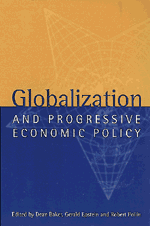Book contents
- Frontmatter
- Contents
- List of figures
- List of tables
- List of contributors
- Editors' acknowledgments
- 1 Introduction
- I The IMF, the World Bank, and neo-liberalism
- II Foreign direct investment, globalization, and neo-liberalism
- III Globalization of finance
- IV Trade, wages and the environment: North and South
- V Migration of people in a global economy
- 13 Freedom to move in the age of globalization
- 14 Immigration, inequality, and policy alternatives
- 15 Notes on international migration suggested by the Indian experience
- Comment on chapters 13–15 by Samir Radwan
- VI Globalization and macroeconomic policy
- Bibliography
- Index
14 - Immigration, inequality, and policy alternatives
Published online by Cambridge University Press: 04 August 2010
- Frontmatter
- Contents
- List of figures
- List of tables
- List of contributors
- Editors' acknowledgments
- 1 Introduction
- I The IMF, the World Bank, and neo-liberalism
- II Foreign direct investment, globalization, and neo-liberalism
- III Globalization of finance
- IV Trade, wages and the environment: North and South
- V Migration of people in a global economy
- 13 Freedom to move in the age of globalization
- 14 Immigration, inequality, and policy alternatives
- 15 Notes on international migration suggested by the Indian experience
- Comment on chapters 13–15 by Samir Radwan
- VI Globalization and macroeconomic policy
- Bibliography
- Index
Summary
The mobility of labor seldom if ever matches that of capital, but the end of the Cold War seemed for a time to be the start of a new era of accelerated population movements. Just as foreign investment and trade restrictions were being widely dismantled, so too were many national barriers to intercountry migration. The most dramatic case was, of course, the opening of Eastern Europe's borders to permit massive outmigration. From 1989 to 1992, over 2.1 million applied for asylum in the West. Concurrently, the European Union moved toward relaxation of internal border checks under the Schengen Accord. And in the United States, new 1990 entry criteria raised considerably the official ceiling on legal green card admissions.
However, by the mid-1990s, all Western European countries had moved to sharply curtail in-migration from non-EU nations, and full implementation of Schengen was being delayed by several countries that were worried about weak external border controls in poorer member states. In the U.S., new restrictive legislation was passed in 1996 to strip most immigrants of important legal protections, exclude them from public assistance programs, impose higher income tests on Americans wishing to sponsor them, and limit claims for political asylum.
This sharp reversal of policy, both here and abroad, reflects in part the emergence of highly nationalistic and ethnocentric political forces opposed on principle to sizable foreign-born populations in their midst. But it is also driven by broader public concerns about the perceived economic impacts of immigration.
- Type
- Chapter
- Information
- Globalization and Progressive Economic Policy , pp. 337 - 356Publisher: Cambridge University PressPrint publication year: 1998
- 3
- Cited by

